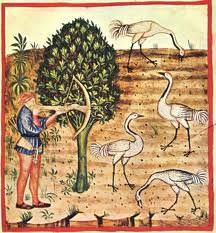Beyond chicken: avian biodiversity in a Portuguese late medieval urban site
Moreno García, Marta and Pimenta, Carlos M.
Birds in Archaeology: 261-275 (2010)
Abstract
A series of 137 silos originally used to storage cereal grains were excavated outside the wall of the city of Beja (Alentejo, Portugal). Avian remains found in 35 of these silos have been analysed with the aim of recognising the economic, social and cultural roles played by birds in this Portuguese urban settlement during the late medieval period. Consumption of domestic fowl and red-legged partridge appears to have been regular whereas other food items such as geese, ducks, pigeons, plovers, crane, little bustard, thrushes and starlings are less frequent. Yet, their occurrence evidences the wide variety of wildfowl exploited, maybe to be served at the upper classes table. Hawking was probably one of the hunting techniques more commonly used.
In addition, hunting of large birds of prey is not only demonstrated by the remains of eagles with cut marks but it is also supported by documentary sources. The manufacture of artefacts from the ulnae of vultures may account for the presence of wing bones of these scavengers among the town refuse. Finally, the pathological condition observed on a tarso-metatarsal of a jackdaw and the cut off spurs of two tarsometatarsals of domestic fowl are tentatively interpreted as archaeological evidence of two diff erent cultural practices: keeping corvids in captivity and cockfi ghting, respectively. It is shown that birds from medieval sites off er an opportunity to highlight aspects of the daily life of an urban community which otherwise would remain unknown.
Beyond chicken: avian biodiversity in a Portuguese late medieval urban site
Moreno García, Marta and Pimenta, Carlos M.
Birds in Archaeology: 261-275 (2010)
Abstract
A series of 137 silos originally used to storage cereal grains were excavated outside the wall of the city of Beja (Alentejo, Portugal). Avian remains found in 35 of these silos have been analysed with the aim of recognising the economic, social and cultural roles played by birds in this Portuguese urban settlement during the late medieval period. Consumption of domestic fowl and red-legged partridge appears to have been regular whereas other food items such as geese, ducks, pigeons, plovers, crane, little bustard, thrushes and starlings are less frequent. Yet, their occurrence evidences the wide variety of wildfowl exploited, maybe to be served at the upper classes table. Hawking was probably one of the hunting techniques more commonly used.
In addition, hunting of large birds of prey is not only demonstrated by the remains of eagles with cut marks but it is also supported by documentary sources. The manufacture of artefacts from the ulnae of vultures may account for the presence of wing bones of these scavengers among the town refuse. Finally, the pathological condition observed on a tarso-metatarsal of a jackdaw and the cut off spurs of two tarsometatarsals of domestic fowl are tentatively interpreted as archaeological evidence of two diff erent cultural practices: keeping corvids in captivity and cockfi ghting, respectively. It is shown that birds from medieval sites off er an opportunity to highlight aspects of the daily life of an urban community which otherwise would remain unknown.
Click here to read this article from Birds in Archaeology
Subscribe to Medievalverse
Related Posts